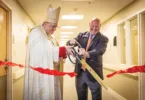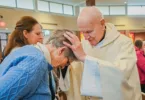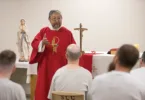
by Joe Bollig
joe.bollig@theleaven.org
KANSAS CITY, Kan. — Everyone in the family knew that Lent was serious business when Denise Godinez was growing up.
All you had to do was look in the kitchen cupboards: All the plates were gone.
“On Ash Wednesday, we would start eating our meals on what we called ‘picnic plates,’” said Godinez, director of religious education at Queen of the Holy Rosary Parish in Overland Park.
“My mother got rid of all our dishes,” she continued. “She cleaned out the cupboards. And that’s what we ate on for 40 days, and they were a smaller size.
“As Holy Week began, we started to see the china come out. So on Easter Sunday, we ate on the china.”
Catholics have many traditions — both small “t” and large “T” — associated with Lent, Holy Week and Easter.
Some of these we know very well and are part of the church’s liturgical patrimony: penance services, Stations of the Cross, the Triduum.
Others are more family-based, like placing a family Rice Bowl on the dining room table to collect change for Catholic Relief Services or making Easter eggs in the kitchen.
Traditionally, Catholics have relied on the three pillars of Lent to guide their preparation for Easter. The three pillars are prayer, fasting and almsgiving.
Lent is a wonderful time for families to get together to truly become “the domestic church” through “digging deeper and being a little creative” with the three pillars of Lent, said Liz Willman, director of adult faith formation and RCIA at Ascension Parish in Overland Park.
When she and her husband Jim were raising their two children, Willman would make a big, black foam cross. Then, she would cut strips from four different colors of construction paper. On the paper, each member of the family would write something they could do during Lent, and then they put the strips in a bowl on their dining room table.
“Every Sunday night we would pick out a slip of paper for the week,” said Willman. “We’d open it, read it and tape it to the foam cross. By the end of Lent the cross was filled with different colors, like a stained-glass window.”
The point she makes with her RCIA class — as well as her family — is that external actions done for Lent should be accompanied by a conversion of the heart.
“If it doesn’t lead to conversion, what’s the point?” she asks.
Here’s another tip: Although the church says abstinence from meat is only required from age 14 on, Willman said it’s better to establish that discipline early.
“Start when they’re 5,” said Willman.
Larissa Smith and her husband Dennis became Catholic in 2015, and their son Brayden is 3 years old, so their family Lenten traditions are new.
“We have a Lenten countdown calendar that gives us things to do every day,” said Smith, coordinator of adult faith formation at Prince of Peace Parish in Olathe.
They also plan to set up a “cozy, quiet Lenten corner” with pillows and age-appropriate books that she and Dennis can read to Brayden.
With a little planning and creativity, and by accessing both online resources and participating in activities at their parish, families can have a wonderful Lent together, said Smith, Willman and Godinez.
Prayer
• Some parishes offer special “family” eucharistic adoration services and “family” Stations of the Cross. If yours does, get them on your family calendar. If yours does not, designate your own. And don’t take only your children — encourage the kids to invite a friend and go out for a simple meal afterward.
• Attend a parish reconciliation service as a family.
• Model to your children the act of praying for someone you are angry with or don’t like.
• Have the children offer their own Lenten prayers before and after meals, or at bedtime.
• Make a family trip to a Catholic bookstore. If there isn’t one near you, ask to borrow books from the parish. Have a family reading time at home.
• Pray a family rosary or Divine Mercy chaplet weekly or daily. If this is too difficult for the younger children, consider praying single mysteries and decades after family meals. Rosaries can be prayed on walks or in the car.
• Have a family Bible time. Pick verses that relate especially to the events of Holy Week. Share them at mealtimes.
• Visit a cemetery as a family to pray for those buried there, especially family members. Discuss how Jesus died and rose from the dead to save us from our sins and give us eternal life.
• Go to the church as a family to say a prayer and light a votive candle. Stay for a brief visit with Jesus in the tabernacle.
• Make a paper daily prayer chain. The weekdays can be purple rings and the Sundays can be white rings. The Triduum can be red and Easter gold. Tear off the rings each day as the family gathers for a short prayer.
Fasting
Traditionally, fasting means eating less food, while abstaining means not eating certain kinds of food, like meat. But we can abstain or “give up” many kinds of things for Lent.
• Compile a list or calendar of things family members can abstain from during Lent: complaining, calling names, arguing, negativity, sarcasm, laziness, being picky, judging others, anger, lying, cursing, snacking, TV, texting, social media, screen time, video games, the internet, favorite apps, favorite treats and snacks.
• Give up materialism. Have a spring cleaning on a designated Saturday. Sort through old clothes, toys and other items and give them to the parish rummage house, Catholic Charities, Goodwill, the Salvation Army or Disabled American Veterans thrift stores. Sit at the dining room table and discuss the importance of not letting materialism take over our lives and crowd out our relationship with God and others.
Almsgiving
Traditionally, almsgiving meant giving money to the poor. But the key concept is the “giving” to meet the needs of someone else. This doesn’t always mean money, so families can choose creative things and ways to give.
• Have a family poor box. Often, Rice Bowls from Catholic Relief Services are made available at the parish, into which the family can toss its change throughout Lent, then return the box for CRS. But families can also make their own Lenten family “poor box” and collect money to be given to a designated charity or ministry at the end of Lent.
• Make a family visit to a nursing home. Decorate some Easter baskets and fill them with goodies or personal care items. Give them to the residents. Be sure to call ahead and ask what things are needed or prohibited, or if there are special requests or considerations.
• Go on a family shopping day to collect items for a food pantry. Contact the pantry to see if there is a need for particular items.
• Make Easter cards for elderly shut-ins in your neighborhood. Ask if they need help for tasks that are difficult for them.
• Perform acts of charity and record them on a list.
• Contact grandparents or other members of your extended family, especially if you’ve fallen out of contact. Set up a regular “inspirational” texting exchange, or get devotional books you can both read and discuss over the phone.
However you decide to mark this special season of the church year, do it as a family.
Incorporating prayer, fasting and almsgiving into your family life this Lent is one of the best ways to fuel your children’s faith, while preparing them to undertake the church’s important work in the world.
And don’t be surprised if along the way, you make some memories that will last a lifetime,
Picnic plates, anyone?






